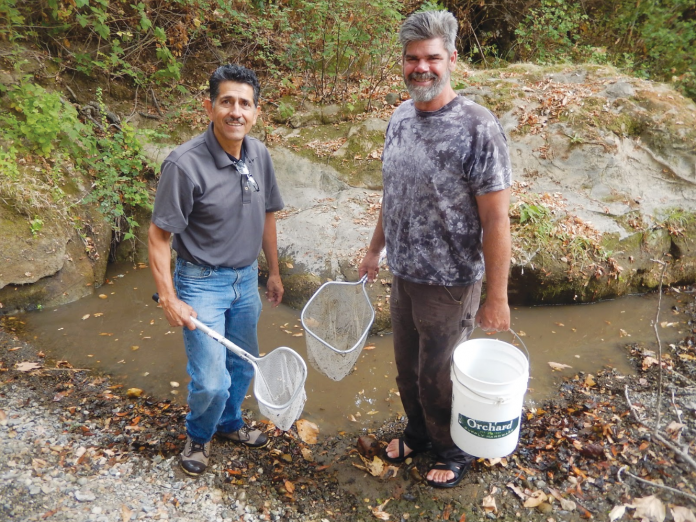
From potbellied pigs to parrots, from ferrets to felines, lots of pets seem to need rescuing these days—but one Gilroy group is rescuing a whole species of wildlife: steelhead trout.
The non-profit Coastal Habitat Education and Environmental Restoration (CHEER) has a track record of getting the job done. For more than a decade CHEER has been the boots-in-the-water savior of steelhead in the four-county Pajaro River Watershed.
CHEER has no paid staff and no office, but with a small army of volunteers and help from state and federal agencies, it has worked since the late 1990s to protect the steelhead and its fragile riparian environment from pollution, predation, dumping, encroachment, illegal fishing and the seasonal whims of a climate that each year turns robust lush, waterways teeming with life into the killing creeks of summer.
Fish rescues are a crucial part of the mission, according to Herman Garcia, CHEER’s charismatic founding president and CEO.
As parts of creeks such as the Uvas and Little Arthur dry up, left behind are sometimes deep pools that slowly lose water to evaporation, Garcia says.
And trapped in those waters are steelhead and every other creature that relies on the watery habitat and its banks for survival.
Others include crappie, chad, bass, crayfish and tadpoles. All die when the water vanishes—and it’s illegal to rescue any of those species, according to Garcia.
But because of the steelhead’s status on the federal government’s protected list, Garcia can and does secure a permit for each rescue mission.
And CHEER does not go out alone, either. Representatives from the California Department of Fish and Wildlife and the regional office of the National Oceanographic and Atmospheric Administration, or NOAA, accompany Garcia on each rescue mission.
So far this season, CHEER has conducted four steelhead rescues, netting—literally—more than 1,200 first-year fish.
They are the small ones, perhaps 1-4 inches in length, the toddlers of the fish world who are most susceptible to summer kill-offs when the rains stop, temperatures soar and creeks dry up.
The federally protected steelhead was once ubiquitous in the Pajaro River Watershed, which includes all or parts of Santa Clara, Santa Cruz, Monterey and San Benito Counties and empties into the Pacific Ocean.
Old timers remember fishing excursions in what is today urban Gilroy that brought in scores if not hundreds of steelhead in an afternoon.
The species lives much of its life in the ocean but returns to the fresh waters of the watershed to spawn one or more times each year. Unlike ocean-going salmon, most of whom die after spawning, steelhead return to the ocean and can spawn again.
The most recent steelhead rescue was August 10 in the Little Arthur Creek in rural, western Gilroy. It mostly flows along Redwood Retreat Road, upstream from its confluence with the larger Uvas Creek, near the intersection of Watsonville and Redwood Retreat roads.
The CHEER team pulled 340 small steelhead from the pools they found by following the “dry back” about four-tenths of a mile upstream from the confluence, according to Garcia.
The fish ranged in size from between 1-2 inches to 4 inches because although all first-year fish, they are the offspring from four separate spawning runs, he said: early winter, winter, late winter and spring.
In addition to a handful of CHEER volunteers and Garcia, the team included NOAA Fisheries Biologist Joel Casagrande, Fisheries Biologist Shawn Cochrane from the California Department of Fish and Wildlife and Dr. Jerry Smith, a retired San Jose State University professor of biological sciences and an expert on steelhead trout.
Volunteers included Roger Castillo and Dan and James Vermilyer.
The number of rescues conducted each year varies, according to Garcia, but none can be planned ahead only planned for.
“We do not dictate when the rescues happen and neither does Fish and Wildlife or NOAA,” he said, “The fish and the weather determine when we go on rescues.”
Under normal rain conditions, the Uvas Creek will stay wet from the face of Uvas Dam downstream to the vicinity of Gilroy Gardens Family Theme Park on Highway 152 and beyond, to Silva’s Crossing on Miller Avenue in Gilroy, near the entrance to Christmas Hill Park, according to Garcia.
But in the drier years, such as the recent drought, and warmest weather years, “dry back” is a fact of life in smaller creeks and tributaries and fish trapped in pools “are in danger of death” if not rescued, he said.
Last week, the team used seine nets and “electro-fishers”—backpack-held stunning tools that help bring the fish to the surface for rescue.
“This is pretty high tech equipment,” said Garcia. “They put the wands on the water and when they push the trigger it sends a shock wave through water and acts sort of like a taser. It shocks the fish momentarily. They become immobile and float to top, then we net them and put them in aerated buckets and within five to 10 seconds they are back to normal,” he said.
From the buckets, the fish are transferred to large tanks in CHEER’s utility truck and taken to viable stretches of the creek nearer the dam face—or sometimes to the Pajaro River south of Gilroy—where they are released.
The steelhead will spend perhaps a year growing and maturing until the next rainy season refills the creeks and reopens for them the 30-plus mile path to the Pacific Ocean at the Monterey Bay Marine Sanctuary.
Mortality rates for the steelhead are not good, so each one rescued counts, according to Garcia. And that is especially true for females that can lay as many as 10,000 eggs in a single spawning, he said.
Of those, 100 might survive to adulthood, according to Garcia.
“By eliminating risk factors for those fish, their survivability is increased,” he said. “We are giving them a better chance to survive.”












